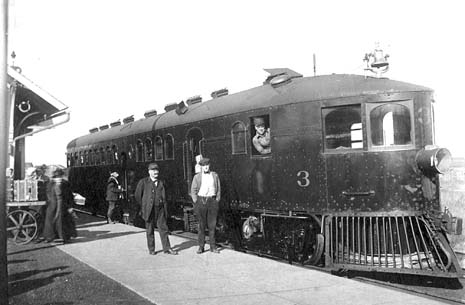

Photo from the Steven C. Schmidt Collection.
Shown above is Ann Arbor Railroad's Gasoline Powered Motor Car No. 3 stopped at the Owosso, Michigan station in the early part of the 20th century. At one time, The Ann Arbor ran between Toledo, Ohio and Frankfort, Michigan. It also operated rail and passenger ferries across Lake Michigan.
The engineer of this car was John Scott who is leaning out the cab window. Charles Shears, the man in uniform, was conductor. On the back of the photo is also the name Will Beresford. Could he be the fellow standing between the conductor and engineer? Was he the Owosso station agent? If anyone knows, please contact me by clicking Hartland B. Smith. Thanks.
Designed to provide more economical passenger operation than a steam powered train, gasoline motor cars were used on many smaller rail lines or branches of larger railroads. They were sometimes referred to as doodlebugs. No. 3 appears to be a product of the McKeen Motor Car Co. The firm's cars utilized gasoline engines which were mechanically connected to the drive wheels. According to Alan Follett, at least one of the McKeen's was later converted to gas-electric operation in the late 20's. It was CGW's #1000.
According to Benn Coifman, a total of 152 McKeen cars were built between 1905 and 1917. They were not very durable and had a tendency to shake themselves apart after a few years of operation.
Bill Waller discovered the following historical material in his vast collection of railroadiana. I regret that I can't credit the author, because no name appears on the original text.
William R. McKeen, Jr., Superintendent of Motive Power for the Union Pacific, in 1905 designed and built the first McKeen motor car in their shops in Omaha. In the following 3 years a number were built to supplant steam trains on lightly traveled branch lines.
In 1908 the demand had become so great that Edward H. Harriman, who controlled both the Union Pacific and Southern Pacific, financed the McKeen Motor Car Company, and production was started in an old shop building in Omaha.
William R. McKeen, Jr. in his design and construction of these motor cars, was far in advance of his time. The wind-splitting front end, the streamlined design throughout, the heavy steel underframe, the all-steel body construction, the center entrance and his use of what were the most powerful marine-type gasoline engines at that time all point to his genius and ingenuity.
Over 50 railroads operated these motor cars. Among the trunk lines to purchase them new were the Union Pacific, Southern Pacific, Northern Pacific, Pennsyulvania, Illinois Central, Rock Island, Chicago Great Western, Chicago & North Western, Erie and Soo Line. Some short lines operated no other passenger equipment.
The standard model was 55 feet in length although some 70-foot cars were built. Passenger trailers were 50 feet long and mail-baggage trailers were 31 feet. These latter cars were originally built with a 4-wheel truck, but most railroads soon rebuilt them with double trucks.
All the motor cars were built with steel bodies, pointed fronts, round backs, port-hole windows and center entrances. Their gasoline engine was mounted crosswise in the front truck with a big flywheel protruding beyond the left-side truck frame. This engine was geared only to the front axle which had 42 inch wheels. The rear axle had 33 inch wheels. It was equipped with a chain drive, an air clutch and had a two-speed transmission.
As built by the McKeen Motor Car Company, the cars had no reverse gears, and to back up it was necessary to stop the motor and re-start it in the oopposite direction after shifting the cam shaft. This proved so troublesome that most railroads installed their own reverse gears.
The Southern Pacific, in numbering their cars, started with No. 1 and used odd numbers for motor cars and even numbers for trailer cars, so the most distinctive numbers on any roster, No. 1 and No. 13 were both assigned to McKeen motors.
The Chicago Great Western rebuilt three of their motor cars into a name train, "The Blue Bird". This included a coach section, sleeping section and a buffet-lounge.
The NEVADA STATE RAILROAD MUSEUM is presently restoring VIRGINIA & TRUCKEE Motorcar 22, a 1910 McKeen unit that was modified into a 70 footer. You can see a photo of the old car enroute to the Museum at V&T 22.
I'll bet that you've never seen a Spiral Ascensionist in action. On the next page there are three 100 year old photos of the daring FILLIAN performing this very unusual and dangerous aerial feat at a Free Fair in Owosso, Michigan.
Click here if you'd prefer to turn back to my HOME PAGEÐ